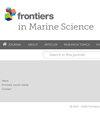Detection of unusually high transcriptomic and proteomic abundance of bromoform-synthesizing halogenase in marine macroalgae Asparagopsis taxiformis
IF 3
2区 生物学
Q1 MARINE & FRESHWATER BIOLOGY
引用次数: 0
Abstract
Halogenated molecules produced by marine algae are thought to be defensive secondary metabolites. The extraordinarily high concentration of bromoform in the seaweed巨藻天冬酰胺中溴化物合成卤化酶转录组和蛋白质组学丰度异常高的检测
海藻产生的卤化分子被认为是防御性次生代谢物。天门冬藻中溴仿的浓度极高,高达干组织重量的8%,挑战了这种范式的排他性。在本报告中,我们提供的证据表明,编码产生溴仿的卤化酶的mbb1基因是天冬酰胺组织中转录率最高的基因之一,其产生的mbb1蛋白丰度与参与光合作用和碳固定的酶的丰度相当。当海藻受到光胁迫时,mbb1和参与光合作用的蛋白质的转录本都显著下调。相反,热胁迫适度上调了一些光合作用基因,但对mbb1没有影响。综上所述,这些发现使我们能够假设甲螨的产溴仿不仅仅是一种应激反应或自卫机制。相反,我们提出卤化酶Mbb1可能在这种红藻中发挥了主要的代谢功能,从而重新定义了卤化生物化学,并将其从天然产物生物合成的领域中拉出来。
本文章由计算机程序翻译,如有差异,请以英文原文为准。
求助全文
约1分钟内获得全文
求助全文
来源期刊

Frontiers in Marine Science
Agricultural and Biological Sciences-Aquatic Science
CiteScore
5.10
自引率
16.20%
发文量
2443
审稿时长
14 weeks
期刊介绍:
Frontiers in Marine Science publishes rigorously peer-reviewed research that advances our understanding of all aspects of the environment, biology, ecosystem functioning and human interactions with the oceans. Field Chief Editor Carlos M. Duarte at King Abdullah University of Science and Technology Thuwal is supported by an outstanding Editorial Board of international researchers. This multidisciplinary open-access journal is at the forefront of disseminating and communicating scientific knowledge and impactful discoveries to researchers, academics, policy makers and the public worldwide.
With the human population predicted to reach 9 billion people by 2050, it is clear that traditional land resources will not suffice to meet the demand for food or energy, required to support high-quality livelihoods. As a result, the oceans are emerging as a source of untapped assets, with new innovative industries, such as aquaculture, marine biotechnology, marine energy and deep-sea mining growing rapidly under a new era characterized by rapid growth of a blue, ocean-based economy. The sustainability of the blue economy is closely dependent on our knowledge about how to mitigate the impacts of the multiple pressures on the ocean ecosystem associated with the increased scale and diversification of industry operations in the ocean and global human pressures on the environment. Therefore, Frontiers in Marine Science particularly welcomes the communication of research outcomes addressing ocean-based solutions for the emerging challenges, including improved forecasting and observational capacities, understanding biodiversity and ecosystem problems, locally and globally, effective management strategies to maintain ocean health, and an improved capacity to sustainably derive resources from the oceans.
 求助内容:
求助内容: 应助结果提醒方式:
应助结果提醒方式:


